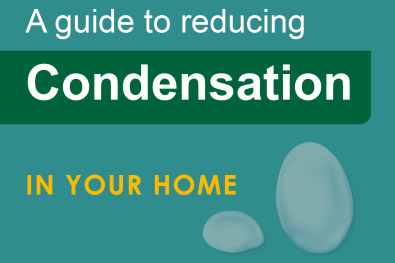Damp and condensation
![]()
Detailed below is information on damp and condensation including some hints and tips on how to avoid it in the home.
 What causes condensation?
What causes condensation?
What are the indicators of condensation?
What can I do to prevent condensation?
Effective use of heating
Is damp or condensation present at my property?
What causes condensation?
Condensation occurs when the warm air in a room comes into contact with a cold surface, such as a window, mirror or wall, and turns into water droplets. This happens more in rooms where there is a lot of moisture, such as bathrooms and kitchens, and in rooms where there are a lot of people.
Moisture from the air can come from normal day-to-day activities such as; using the kettle, cooking, bathing, breathing and washing/drying laundry.
Read our 'Healthy Homes' leaflet for more informaiton about how to tackle condensation.
What are the indicators of condensation?
- Water droplets on cold surfaces
- Black spot mould
- Wet rot – on skirting boards
- A musty smell
- Spoiled paintwork or plaster
Preventative measures
- Don’t dry laundry on radiators
- Dry clothes outside where possible or on a clothes airer in a cool room
- Make sure tumble dryers are vented correctly
- Keep lids on pans when cooking
- Whilst cooking or bathing, close doors to other rooms
- Use extractors in kitchens and bathrooms if you have one
- Open windows if it’s not damp outside
- When running a bath, start with cold water first
- After a bath or shower try to ventilate the room to the outside not to the rest of the house
- When people come in with wet coats, try to hang the coats outside of the living area to dry.
- Consider using a dehumidifier. They don’t cost a lot and can remove a surprising amount of water from the air
- Wipe down tiles to remove surface water
- Don’t place furniture against an outside wall
- Wipe down windows if water droplets appear.
Effective use of heating
Keep thermostats at a warm temperature, not too hot. A constant temperature is much more energy efficient as the boiler won’t need to work as hard.
If after following these guidelines you are still getting a build-up of condensation in your home, contact us and we may be able to find an answer to the problem.
Please also view our 'cost of living' pages which details energy saving tips and how to contact our advice teams if you are struggling to pay your bills.
Is damp or condensation present at my property?
If yellow water marks are present on your ceiling or walls, or you are unsure if your property has condensation please contact the repairs line on 01952 217217.
Damp and condensation works are put through to the planned programme for further investigation. The Group will treat the area affected by the mould, it is then up to the tenant to make sure preventative measures are carried out.
For further information please look at our guide to reducing condensation in your home (PDF 181kb).